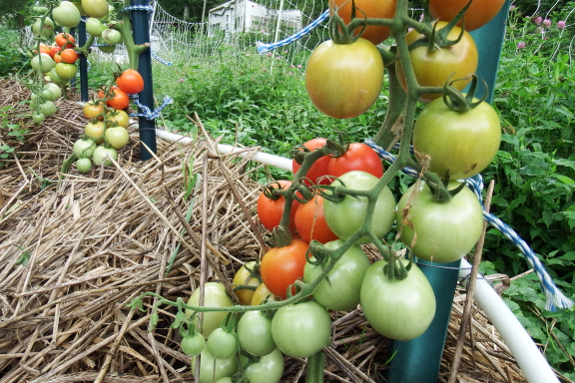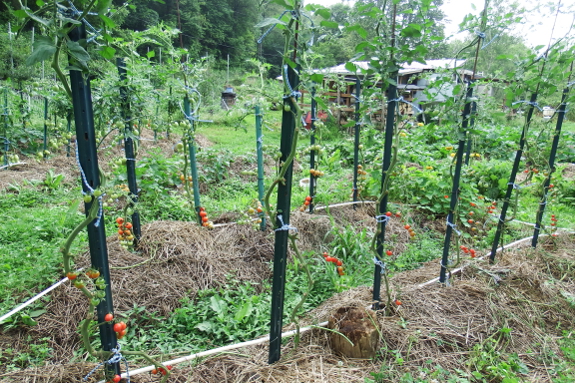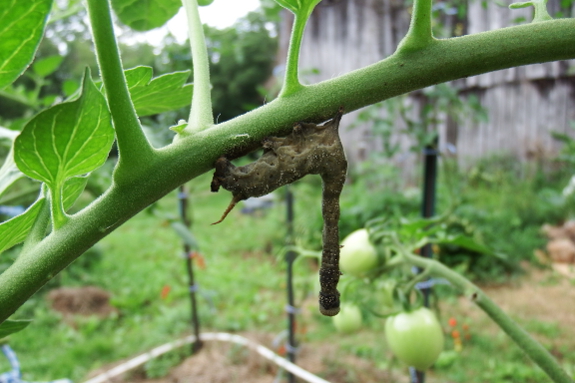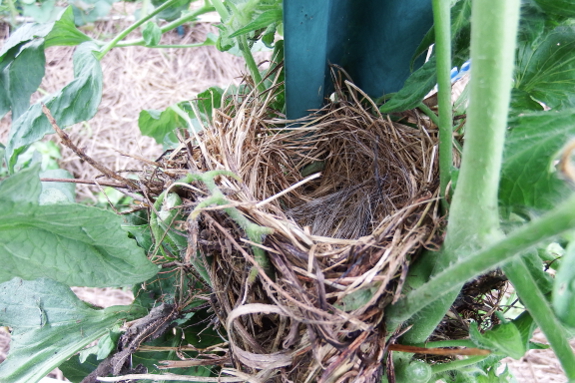
Tomato highs and lows in mid July

Our tomatoes are finally
ripening fast enough that I think we'll be able to make our first pot of
soup this week. That's good news since vegetable soup is a mainstay of our winter diet --- time to get cracking!

The bad news is that I'm pruning the plants higher and higher as the blights
spread. Septoria was soon joined by small outbreaks of early blight,
and I'm very afraid that the dreaded late blight has entered the fray
now. I'm ready to deem these new blight-resistant tomato varieties
a dismal failure --- flavor isn't nearly as good as the heirlooms I'd
been growing, and they don't appear to showcase any extra blight
resistance at all.
Next year, we may try yet another anti-blight experiment --- creating an
anti-rain canopy out of clear plastic over the tomato patch. Like a
greenhouse with no walls....

On the positive side
again, hornworms are appearing...and disappearing nearly as quickly as
they show up. This little guy doesn't even appear to have lived long
enough to get parasitized by wasps. Perhaps this is an example of the plant creating anti-nibbler pesticides within its leaves?

Meanwhile, a song sparrow
family has moved into one of my tomato plants. I'd thought that the
mother bird would give up on the nest once I pruned away blighted leaves
that used to shield the contents from rain and view. But Tuesday I
found a tiny spotted egg inside, nestled atop Abigail's hair. Looks like
our resident sparrow couple will have another successful nesting this
year! Round one occurred in the hardy kiwis, and I was treated to the
inspiring view of one of the babies waking up from its nap and gaping
for food before I let the vines curl back over nest #1. Here's hoping
Mama Sparrow does as well with round two.
Want more in-depth information? Browse through our books.
Or explore more posts by date or by subject.
About us: Anna Hess and Mark Hamilton spent over a decade living self-sufficiently in the mountains of Virginia before moving north to start over from scratch in the foothills of Ohio. They've experimented with permaculture, no-till gardening, trailersteading, home-based microbusinesses and much more, writing about their adventures in both blogs and books.
Want to be notified when new comments are posted on this page? Click on the RSS button after you add a comment to subscribe to the comment feed, or simply check the box beside "email replies to me" while writing your comment.

Not sure if this will alway work, but out of space necessity, I put tomatoes up against a bee balm patch, which seems to have protected them. Somehow I feel that strong-scented herbs, incl. sage, might be good for tomatoes.
Maybe your mulch is too thick, and gets too soggy?